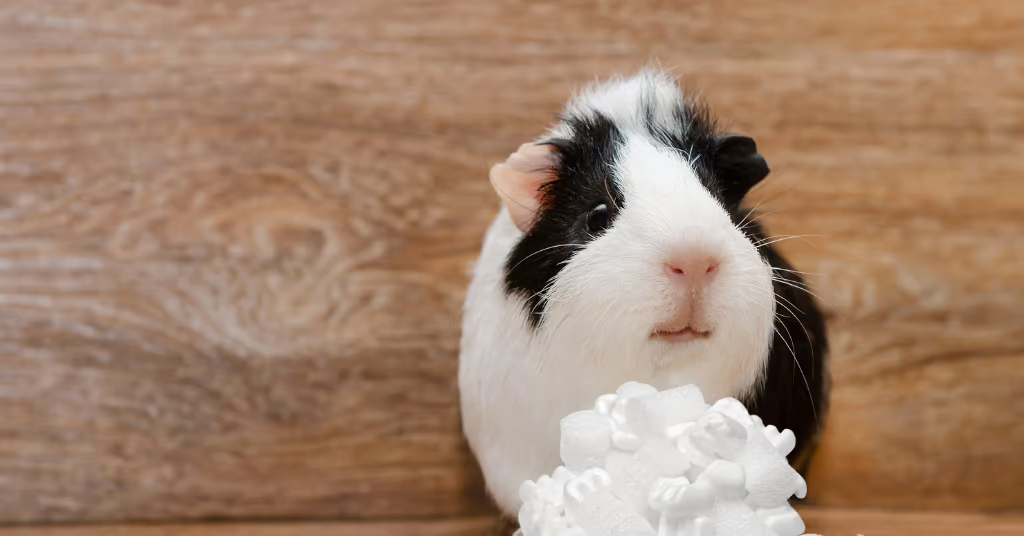So your guinea pig ate styrofoam and now you are worried about the potential health implications this could have for your beloved pet. While it’s not the most ideal situation, there’s no need to panic. Here’s what you need to know about guinea pigs and styrofoam.

My guinea pig ate styrofoam, will he be ok?
Guinea pigs are curious creatures, and it’s not uncommon for them to chew on things they shouldn’t. If your guinea pig has eaten styrofoam, you may be wondering if there will be any consequences.
Fortunately, styrofoam is actually fairly harmless to guinea pigs. It is made of polystyrene, which is an inert material that doesn’t break down in the stomach.
This doesn’t mean it’s perfectly safe to eat. Styrofoam contains chemicals that can react with heat and acid and leech into the body.
These are styrene and diethylhexyl adipate. Luckily small amounts won’t leech enough of these chemicals to be an issue.
However, there is a bigger issue with eating styrofoam. If your guinea pig swallows enough of it, it could impact its digestive system and cause an obstruction.
For this reason, it’s important to keep an eye on your guinea pig and make sure it is poopIng and peeing regularly.
If you notice that your guinea pig is having trouble going to the bathroom, or if it seems to be in pain, contact your veterinarian immediately.
Another hazard is not with the chemical makeup of the styrofoam itself but what other chemicals and dyes could have come into contact with it.
For example, if your guinea pig ate styrofoam that had been used to package food, there is a risk of food poisoning.
So while the polystyrene in styrofoam isn’t toxic to guinea pigs, it’s still important to be cautious about what else might have come into contact with the material.
If you’re ever in doubt, the best thing to do is to contact your veterinarian. They will be able to give you specific advice based on your guinea pig’s health and situation.

How does styrofoam affect the digestive system of a guinea pig?
Styrofoam can pose a risk to guinea pigs if they eat too much of it. The indigestible material can cause blockages in the stomach, esophagus, and intestines, leading to serious health problems.
In some cases, surgery may even be necessary to remove the blockage. Therefore, it’s important to keep an eye on your guinea pig if they have access to styrofoam and make sure they don’t consume too much of it.

What should you do if your pet eats styrofoam or any other foreign objects
If your guinea pig eats styrofoam or any other foreign objects, the first thing you should do is monitor its digestive function.
Pay close attention to their poop and pee, and if you notice any changes, or it stops altogether, take them to the vet immediately.
It’s also important to be proactive in preventing your pet from eating foreign objects in the first place.
Keep an eye on them when they’re outside, and make sure they don’t have access to any potential hazards. If you are ever in doubt, err on the side of caution and take them to the vet for a check-up.
Signs of impaction are:
- Lethargy
- Decreased appetite
- Weight loss
- Abnormal stool (e.g., small, hard pellets)
- Straining to defecate
- Constipation
- Vomiting
If your guinea pig is showing any of these signs, contact your veterinarian immediately. They will be able to give you specific advice on how to proceed.

When to seek professional help
If any of the signs above present themselves, it is best to seek professional help from a veterinarian as soon as possible.
If a bad blockage has occurred, a vet may attempt to push it through or pull it out, or in extreme cases, do surgery to remove it.
What are the long-term effects of eating styrofoam?
Styrofoam is a common material used in food packaging, and it’s considered safe for such, but it can have harmful effects on your pet’s health if eaten for long periods of time.
Polystyrene foam contains the chemical styrene, which has been linked to cancer, vision and hearing loss, impaired memory and concentration, and nervous system effects.
Exposure to styrene can also cause headaches, fatigue, and dizziness.
Long-term exposure to styrene may also disrupt hormone function and increase the risk of infertility. Given the potential risks, it’s best to keep styrofoam far away from your guinea pig!


